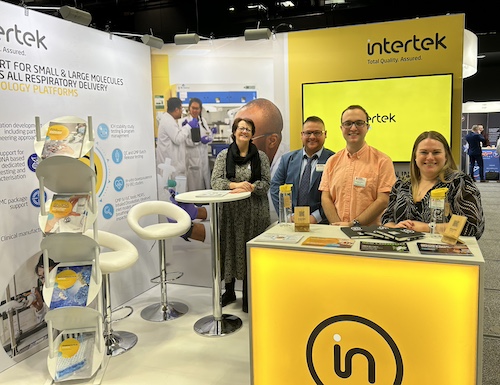About a half dozen posters in the poster exhibition also related to RNA delivery, and in the exhibition, Intertek promoted its expertise in development of inhaled biologics formulations, including DNA-based therapies.
Other talks on inhaled and nasal delivery of biologics included a discussion by Chrishan Samuel of Monash University on “The intranasal delivery of stem cell-based therapies as an emerging approach to treating lung disorders”; 2017 Emerging Scientist Award Winner Francesca Buttini‘s talk on “Lactic Acid Bacteria Dry Powder Inhaler as Promising Tool for Pseudomonas aeruginosa Growth Inhibition in Pulmonary Dysbiosis”; and Joana Pinto da Silva of the University of Algarve described her use of microparticles made from spray-dried locust bean gum for delivery of bacterial lysates to the lung, work that Pinto da Silva’s PhD supervisor Ana Grenha touched on during her talk on the possible use of various polysaccharides in inhaled formulation at DDL 2022.
Other talks on formulation strategies included Hanne Nielsen of the University of Copenhagen discussing her work comparing antibiotic formulations using lipid-polymer solid particles and biopolymer soft nanogels based on hyaluronic acid designed to diffuse into mucus or biofilms. David Cipolla of Insmed, formerly of Aradigm described “Formulation and Chemistry Strategies to Overcome Pulmonary Drug Delivery Barriers,” presenting cases studies including the use of pro-drugs, as with treprostinil palmitil inhalation powder (TPIP), and liposomal formulations, including liposomal ciprofloxacin and liposomal amikacin. Eride Quarta of the University of Parma provided an update on the work of Project Cupido, talking about early development of an inhaled nano-in-microparticle mimetic peptide for the treatment of chronic heart failure, which is being taken forward by Italian start-up NanoPhoria.
Chiara Migone from the University of Pisa presented a talk on her work formulating enoximone as an inhaled therapy for acute pulmonary distress syndrome. Because Perfan enoxidone, which is currently marketed as an injectable for the treatment of congestive heart failure, is not stable enough for nebulization, Migone turned to cyclodextrines as stabilizing agents, allowing for creation first of an inhalation solution and then of a dry powder formulation for inhalation.



